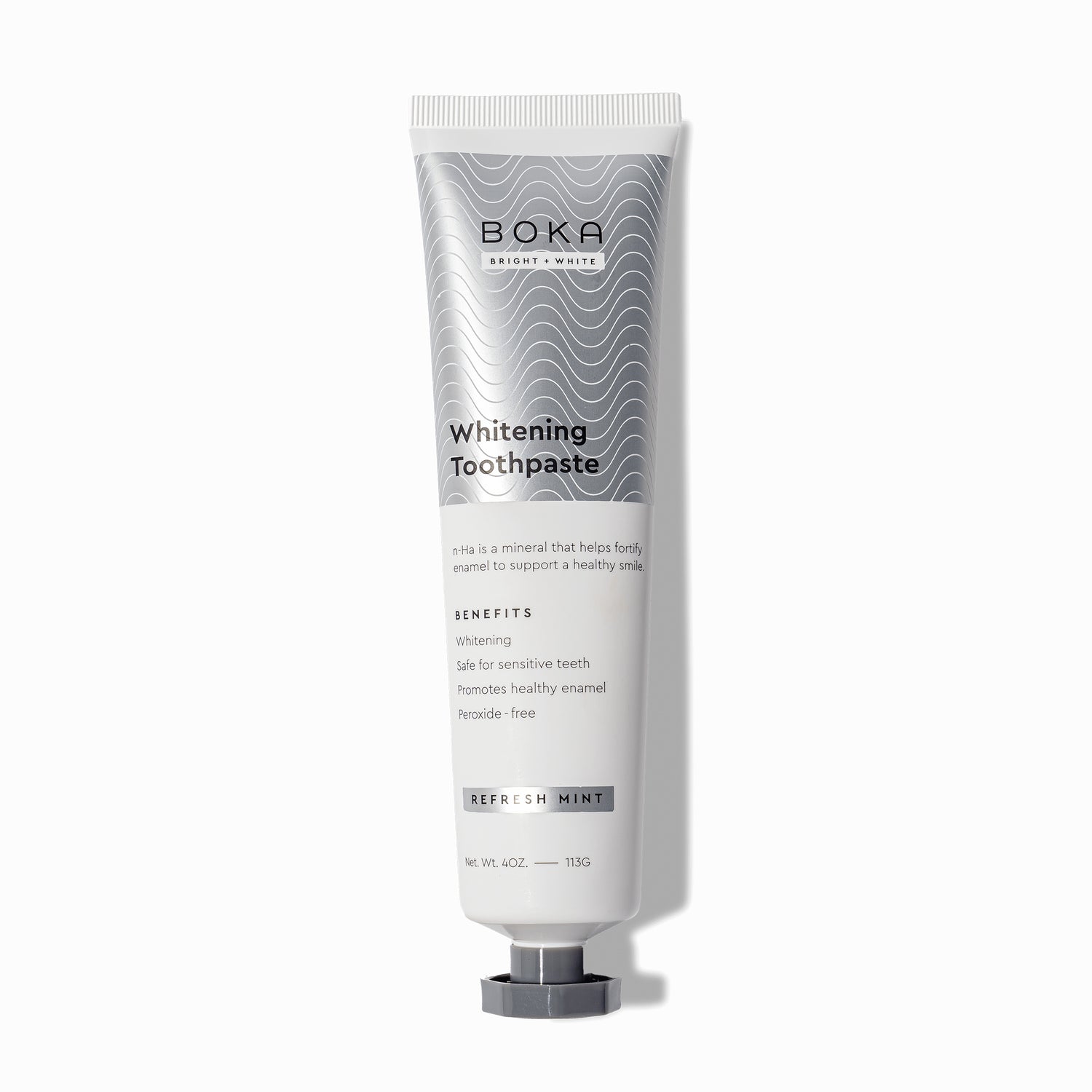Can adults use kids toothpaste? This may be a question that weighs on your mind frequently (or one you have paid no mind to at all before).
However, in an age where people are becoming increasingly conscious of what they are putting into their bodies, the question says a lot about peoples’ sentiments regarding a very controversial ingredient: fluoride.
The essence of the question is that yes – adults can use kids’ toothpaste. However, it is a more nuanced question than you might think!
Adult and children teeth are different, and therefore need to be cared for in different ways. This is the reason why kids’ toothpaste was developed in the first place.
Adults have oral hygiene needs that are met by regular toothpaste, but a lot of people seek alternatives for multiple reasons. Perhaps they have fluoride allergies, teeth and/or gum sensitivity, or other health-related concerns regarding toothpaste ingredients.
In this post, we’ll emphasize:
- The differences between kids’ toothpaste and regular toothpaste
- The ramifications of these differences (both positive and negative)
- A comprehensive rundown of how Boka’s non-toxic, fluoride-free n-Ha toothpaste is a perfect solution to your worries.
Let’s get into it!
Differences Between Kids' Toothpaste And Regular Toothpaste
|
Parameter |
Kids' Toothpaste |
Adult Toothpaste |
|
Fluoride content |
Much lower to avoid health-related side effects of fluoride consumption |
Higher than kids’ toothpaste to provide effective protection against cavities and promote healthy enamel |
|
Abrasiveness |
Less abrasive to protect still-forming teeth |
More abrasive in order to give fully formed teeth a thorough clean |
|
Flavor |
Multiple flavor options to set good oral hygiene habits in place |
Still multiple flavor options, however usually revolving around minty flavors |
|
Ingredients |
Less fluoride and more flavor-altering agents |
Higher fluoride content, less flavor altering agents |
|
Purpose |
Striking the balance between effective cleaning and protection of still-forming teeth |
Providing a comprehensive clean to fully formed teeth, protecting against cavities, and promoting healthy enamel. |
Lower fluoride content
The high fluoride content in regular toothpaste provides effective cavity protection to adults.
However, children are more likely to swallow toothpaste than adults, and excessive fluoride ingestion can lead to a cosmetic issue called dental fluorosis.
This is where the teeth’s enamel is affected. Therefore, kids’ toothpaste generally has a lower fluoride concentration than regular toothpaste.
The American Dental Association recommends children under the age of three should only use a smear of toothpaste with a fluoride content of no greater than 1,000 ppm (parts per million).
In a comparative study published in the National Library of Medicine of the US that compared the two kids' toothpastes with one adult regular toothpaste, it was found that all three toothpastes showed remineralizing potential, but the adult regular toothpaste showed a higher healing potential compared to the pediatric toothpaste.
Meanwhile, kids the same age should only use a pea-sized amount with the same fluoride concentration.
Kid-friendly flavors
Kids’ toothpaste often comes in a multitude of different flavors, such as bubblegum or fruit. This is intended to encourage regular brushing and set good oral hygiene habits in place from an early age.
While there is also variation in regular toothpaste flavors, they usually revolve around minty flavors which could potentially be less appealing to younger children.
The selection of toothpaste flavor types for children of different ages should ideally be based directly on preference data from children. Flavors perceived as pleasant during brushing studies have been linked to increased brushing time, which, in turn, can increase the delivery and efficacy of fluoride from toothpastes. Therefore, manufacturers select tested, child-friendly flavors to maximize compliance, providing a more pleasurable brushing experience and oral health benefits.
Foam less than regular toothpaste
Kids often find the foam produced by regular toothpaste to be unpleasant. The agent that makes toothpaste foam – sodium lauryl sulfate (SLS) – can also be a mild irritant.
For younger children, low levels of foam from a mild surfactant system are probably most appropriate, but for older children (about 6–12 years of age) with mixed dentition, having a higher level of foam is more desirable to move them into an adult-type paste.
Gentle abrasive ingredients
Kids’ toothpaste often includes gentler abrasive components than regular toothpaste in order to clean teeth without being overly harsh on developing enamel. This balance is key for the effective cleaning and protection of still-forming teeth.
Regular toothpaste, on the other hand, usually contains more abrasive ingredients to give fully formed teeth a thorough clean.
Two measures commonly used to assess the abrasivity of a toothpaste formulation are relative dentine abrasivity (RDA) and relative enamel abrasivity (REA), and these are typically assessed using the methodology detailed by Hefferren and recommended by ISO 11609 and the American Dental Association. An upper limit of 250 (for RDA) or 40 (for REA) for a toothpaste is considered safe for everyday use in adults, but no limit has been established specifically for children.
What does it mean for you?
Let's discuss the pros and cons of using kids' toothpaste as an adult.
What’s Good
Milder flavors may be more appealing
Some people don’t enjoy the limited flavors on offer in the majority of regular toothpaste.
That’s okay! If you find yourself gravitating naturally towards a fruitier, sweeter flavor, you may be more inclined to use kids’ toothpaste once in a while.
A study published in 2020 on “Children's perspective on color, smell, and flavor of toothpaste“ found that 50% of the children wanted their toothpaste to taste sweet, followed by minty (20%), sour (14%), and spicy (11%). When asked about what they would like their toothpaste to smell like, majority (41%) of children opted for fruity, followed by sweet (23%), minty (18%), and fragrant (16%).
Lower fluoride content may be suitable for those with fluoride sensitivities
Allergies to fluoride are a very real thing. And like any allergy, fluoride allergies can range from mild to severe.
If this describes you and have ever experienced mouth lesions, swelling, fatigue, or anything else, it would be strongly recommended that you find a fluoride-free alternative to regular toothpaste.
A new ingredients in town have proven to be just as effective as fluoride and completely non-toxic. It's called hydroxyapatite. Nano-hydroxyapatite toothpaste is good and safe alternative to fluoride toothpaste. (like Boka!).
For more information on this topic, feel free to read our article: Why Avoid Fluoride in Toothpaste?
You don’t need to have a fluoride allergy to want to find a toothpaste that is gentler on your teeth and gums.
If you find that using regular toothpaste is an unpleasant experience, we would definitely recommend seeking a fluoride-free alternative!
What’s The Drawback?
Lower fluoride content may provide less cavity protection
Fluoride is a staple toothpaste ingredient because of its cavity protection qualities.
Opting for a kids' toothpaste (or one with lower fluoride content) may compromise the amount of cavity protection you are getting from your primary oral hygiene avenue.
This is definitely something to think about when considering making the switch to kids’ toothpaste!
May not address specific adult dental needs like tartar control or gum health
Childrens’ teeth and adults’ teeth are different – plain and simple. There are some adult-specific oral hygiene needs that simply won’t be addressed by using kids’ toothpaste, such as tartar control and gum health.
This also includes cosmetic needs such as breath freshening and teeth whitening. If you are planning on using kids’ toothpaste as an adult, ensure you have an alternative means of meeting these oral hygiene needs!
May not have the desired minty freshness for some adults
To continue on from the topic of breath freshness, the milder, often fruity flavors available in kids’ toothpaste may not satiate many adults’ need for minty, fresh breath.
While there are other options available in order to achieve this such as mouthwash and breath mints, you most likely gain minty fresh breath from kids’ toothpaste alone.
Try Boka’s non-toxic and fluoride-free toothpaste
Boka specializes in nano-hydroxyapatite (n-Ha) toothpaste – a non-toxic, fluoride-free alternative to the vast majority of other toothpaste options on the market in 2024.
If you are tired of using regular toothpaste but want superior dental care to kids’ toothpaste, Boka’s n-Ha toothpaste is for you!
Boka’s n-Ha toothpaste helps to remineralize, fortify, and whiten teeth, as well as freshen breath. It offers a perfect alternative for those with fluoride sensitivities, generally sensitive teeth, or a yearning for something new.
It is also vegan and cruelty free! We believe brushing your teeth should be a relaxing, almost meditative activity; Boka’s n-Ha toothpaste is one of very few allowing for complete peace of mind.
If you are tired of the high-fluoride content toothpaste on the shelves of your local supermarkets and pharmacies but want superior oral protection, try Boka’s non-toxic and fluoride-free n-Ha toothpaste today!
Related Reads:
- Is Nano-Hydroxyapatite Better Than Fluoride? (Comparison)
- Does Fluoride-Free Toothpaste Work?
- Do Adults Need Fluoride Toothpaste?
- What To Look For In Toothpaste?
- Floss Before or After Brushing: Here’s What Experts Say
- How Long Should You Brush Your Teeth? (+Expert Tips)
- Are Electric Toothbrushes Better Than Manual?
- 6 Surprising Benefits of Oral Probiotics for a Healthier Mouth and Body
- Why Avoid Fluoride in Toothpaste?


